Strategic Analysis of Chipotle Mexican Grill: Competitive Landscape
VerifiedAdded on 2021/04/24
|30
|6026
|39
Report
AI Summary
This comprehensive report provides a detailed analysis of Chipotle Mexican Grill's competitive strategy within the fast-casual restaurant industry. The report begins with an introduction to the industry, highlighting its growth and key trends. It then delves into the strategic issues facing Chipotle, including challenges in employee retention, criticisms, slowing sales growth, and supply chain problems. The report explores Chipotle's vision and business model, utilizing a Business Canvas Model and PEST analysis to examine external factors. An in-depth industry analysis follows, including an assessment of dominant economic traits, Porter's Five Forces, and a strategic group map. Key success factors, such as menu simplicity and efficient operations, are also examined. The report includes a competitive analysis, SWOT analysis, and value chain analysis of Chipotle, along with a financial analysis and conclusion. Recommendations are provided to address the strategic issues and enhance Chipotle's competitive position. The report offers insights into Chipotle's competitive advantages, strategic moves by competitors, and the attractiveness of the fast-casual industry. Finally, financial trends and red flags are discussed.
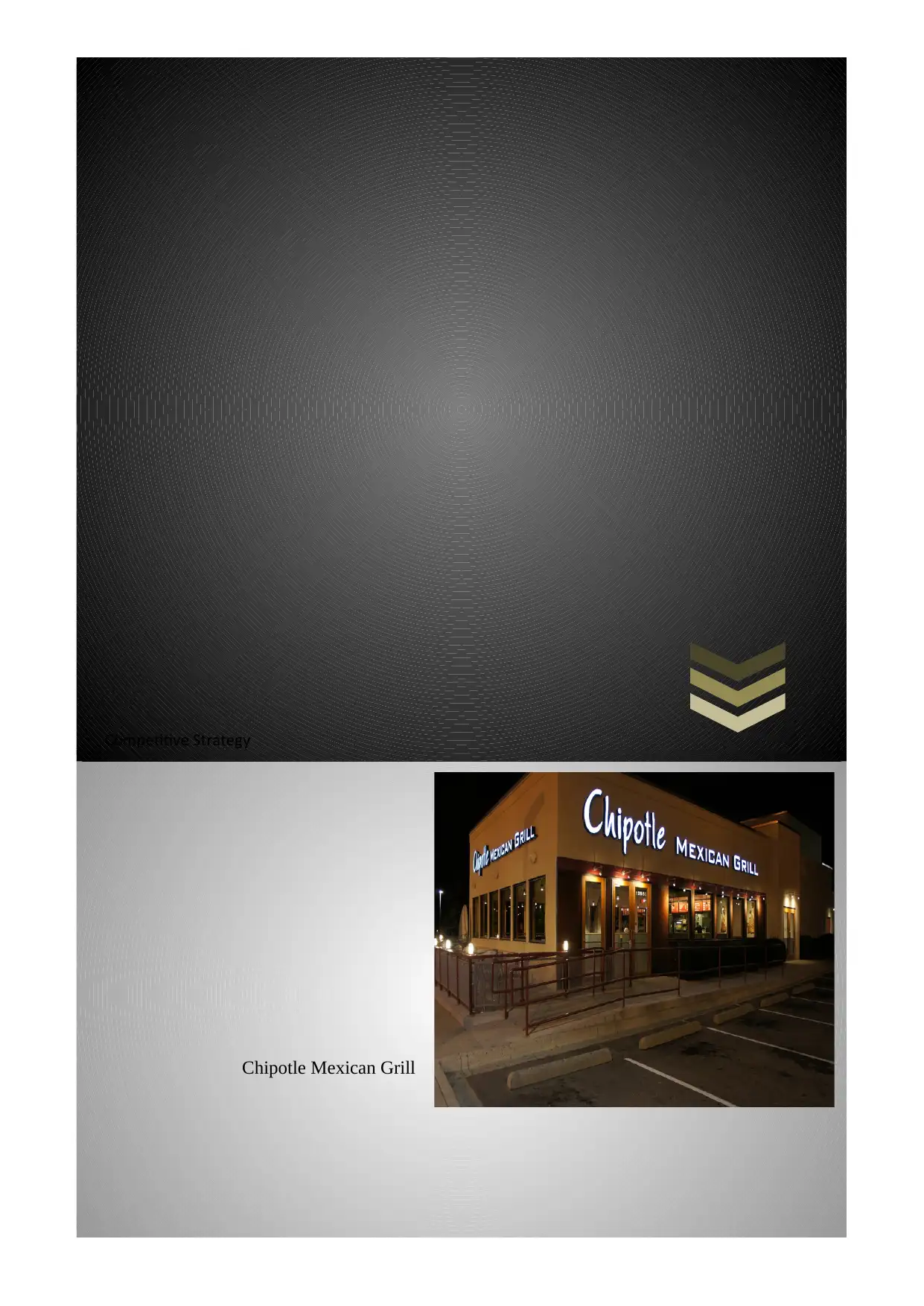
Competitive Strategy
Chipotle Mexican Grill
Chipotle Mexican Grill
Paraphrase This Document
Need a fresh take? Get an instant paraphrase of this document with our AI Paraphraser
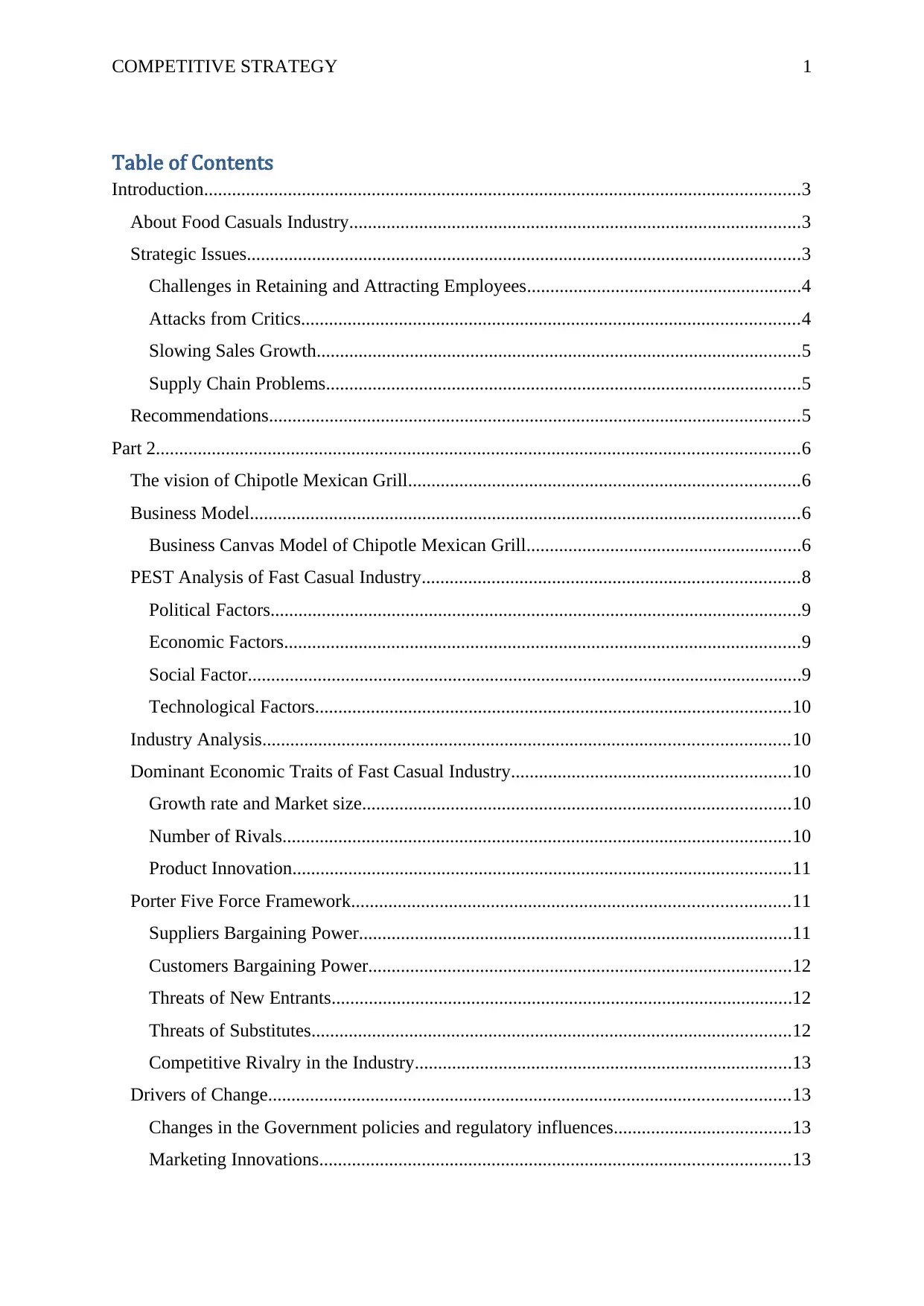
COMPETITIVE STRATEGY 1
Table of Contents
Introduction................................................................................................................................3
About Food Casuals Industry.................................................................................................3
Strategic Issues.......................................................................................................................3
Challenges in Retaining and Attracting Employees...........................................................4
Attacks from Critics...........................................................................................................4
Slowing Sales Growth........................................................................................................5
Supply Chain Problems......................................................................................................5
Recommendations..................................................................................................................5
Part 2..........................................................................................................................................6
The vision of Chipotle Mexican Grill....................................................................................6
Business Model......................................................................................................................6
Business Canvas Model of Chipotle Mexican Grill...........................................................6
PEST Analysis of Fast Casual Industry.................................................................................8
Political Factors..................................................................................................................9
Economic Factors...............................................................................................................9
Social Factor.......................................................................................................................9
Technological Factors......................................................................................................10
Industry Analysis.................................................................................................................10
Dominant Economic Traits of Fast Casual Industry............................................................10
Growth rate and Market size............................................................................................10
Number of Rivals.............................................................................................................10
Product Innovation...........................................................................................................11
Porter Five Force Framework..............................................................................................11
Suppliers Bargaining Power.............................................................................................11
Customers Bargaining Power...........................................................................................12
Threats of New Entrants...................................................................................................12
Threats of Substitutes.......................................................................................................12
Competitive Rivalry in the Industry.................................................................................13
Drivers of Change................................................................................................................13
Changes in the Government policies and regulatory influences......................................13
Marketing Innovations.....................................................................................................13
Table of Contents
Introduction................................................................................................................................3
About Food Casuals Industry.................................................................................................3
Strategic Issues.......................................................................................................................3
Challenges in Retaining and Attracting Employees...........................................................4
Attacks from Critics...........................................................................................................4
Slowing Sales Growth........................................................................................................5
Supply Chain Problems......................................................................................................5
Recommendations..................................................................................................................5
Part 2..........................................................................................................................................6
The vision of Chipotle Mexican Grill....................................................................................6
Business Model......................................................................................................................6
Business Canvas Model of Chipotle Mexican Grill...........................................................6
PEST Analysis of Fast Casual Industry.................................................................................8
Political Factors..................................................................................................................9
Economic Factors...............................................................................................................9
Social Factor.......................................................................................................................9
Technological Factors......................................................................................................10
Industry Analysis.................................................................................................................10
Dominant Economic Traits of Fast Casual Industry............................................................10
Growth rate and Market size............................................................................................10
Number of Rivals.............................................................................................................10
Product Innovation...........................................................................................................11
Porter Five Force Framework..............................................................................................11
Suppliers Bargaining Power.............................................................................................11
Customers Bargaining Power...........................................................................................12
Threats of New Entrants...................................................................................................12
Threats of Substitutes.......................................................................................................12
Competitive Rivalry in the Industry.................................................................................13
Drivers of Change................................................................................................................13
Changes in the Government policies and regulatory influences......................................13
Marketing Innovations.....................................................................................................13
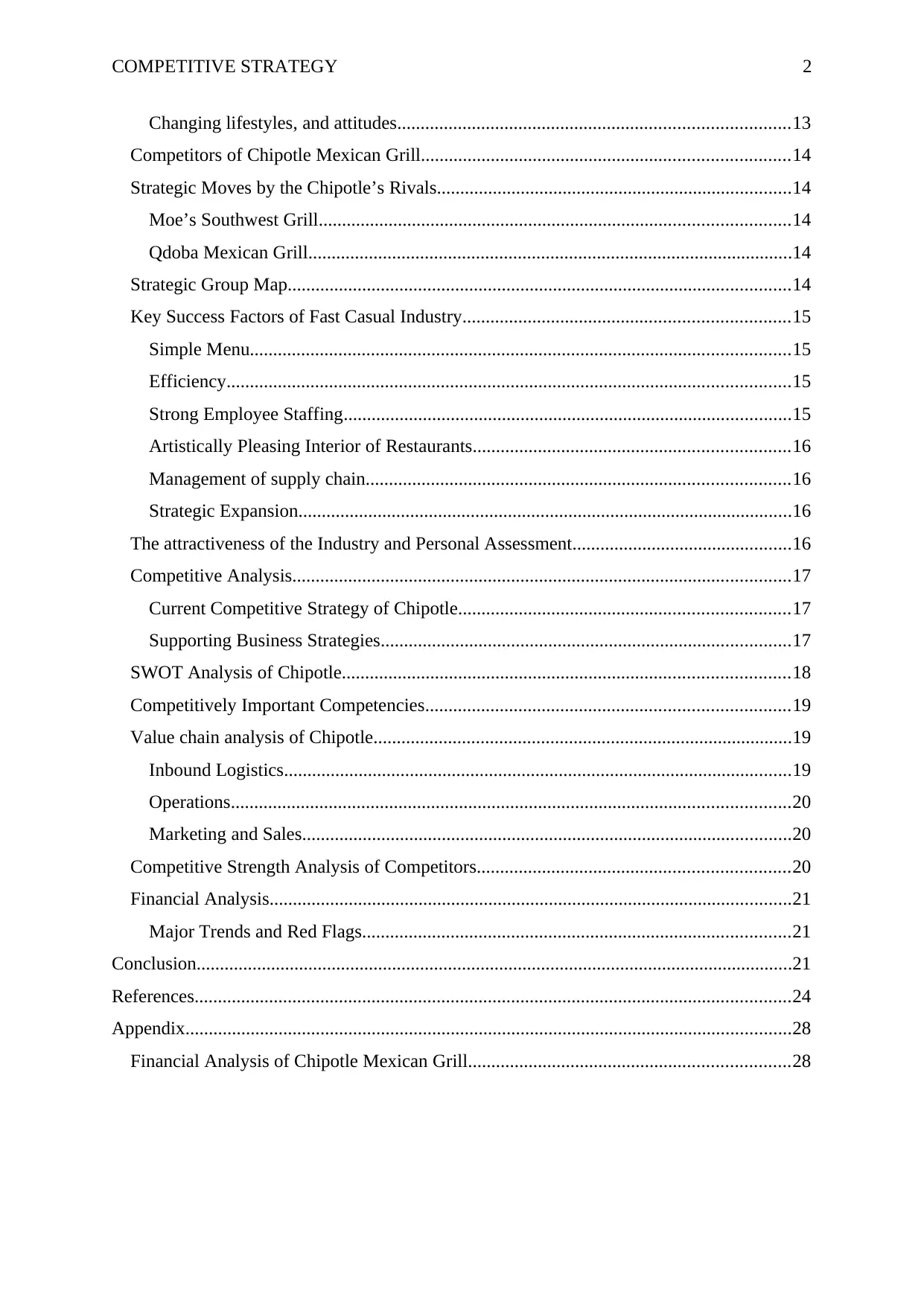
COMPETITIVE STRATEGY 2
Changing lifestyles, and attitudes....................................................................................13
Competitors of Chipotle Mexican Grill...............................................................................14
Strategic Moves by the Chipotle’s Rivals............................................................................14
Moe’s Southwest Grill.....................................................................................................14
Qdoba Mexican Grill........................................................................................................14
Strategic Group Map............................................................................................................14
Key Success Factors of Fast Casual Industry......................................................................15
Simple Menu....................................................................................................................15
Efficiency.........................................................................................................................15
Strong Employee Staffing................................................................................................15
Artistically Pleasing Interior of Restaurants....................................................................16
Management of supply chain...........................................................................................16
Strategic Expansion..........................................................................................................16
The attractiveness of the Industry and Personal Assessment...............................................16
Competitive Analysis...........................................................................................................17
Current Competitive Strategy of Chipotle.......................................................................17
Supporting Business Strategies........................................................................................17
SWOT Analysis of Chipotle................................................................................................18
Competitively Important Competencies..............................................................................19
Value chain analysis of Chipotle..........................................................................................19
Inbound Logistics.............................................................................................................19
Operations........................................................................................................................20
Marketing and Sales.........................................................................................................20
Competitive Strength Analysis of Competitors...................................................................20
Financial Analysis................................................................................................................21
Major Trends and Red Flags............................................................................................21
Conclusion................................................................................................................................21
References................................................................................................................................24
Appendix..................................................................................................................................28
Financial Analysis of Chipotle Mexican Grill.....................................................................28
Changing lifestyles, and attitudes....................................................................................13
Competitors of Chipotle Mexican Grill...............................................................................14
Strategic Moves by the Chipotle’s Rivals............................................................................14
Moe’s Southwest Grill.....................................................................................................14
Qdoba Mexican Grill........................................................................................................14
Strategic Group Map............................................................................................................14
Key Success Factors of Fast Casual Industry......................................................................15
Simple Menu....................................................................................................................15
Efficiency.........................................................................................................................15
Strong Employee Staffing................................................................................................15
Artistically Pleasing Interior of Restaurants....................................................................16
Management of supply chain...........................................................................................16
Strategic Expansion..........................................................................................................16
The attractiveness of the Industry and Personal Assessment...............................................16
Competitive Analysis...........................................................................................................17
Current Competitive Strategy of Chipotle.......................................................................17
Supporting Business Strategies........................................................................................17
SWOT Analysis of Chipotle................................................................................................18
Competitively Important Competencies..............................................................................19
Value chain analysis of Chipotle..........................................................................................19
Inbound Logistics.............................................................................................................19
Operations........................................................................................................................20
Marketing and Sales.........................................................................................................20
Competitive Strength Analysis of Competitors...................................................................20
Financial Analysis................................................................................................................21
Major Trends and Red Flags............................................................................................21
Conclusion................................................................................................................................21
References................................................................................................................................24
Appendix..................................................................................................................................28
Financial Analysis of Chipotle Mexican Grill.....................................................................28
⊘ This is a preview!⊘
Do you want full access?
Subscribe today to unlock all pages.

Trusted by 1+ million students worldwide
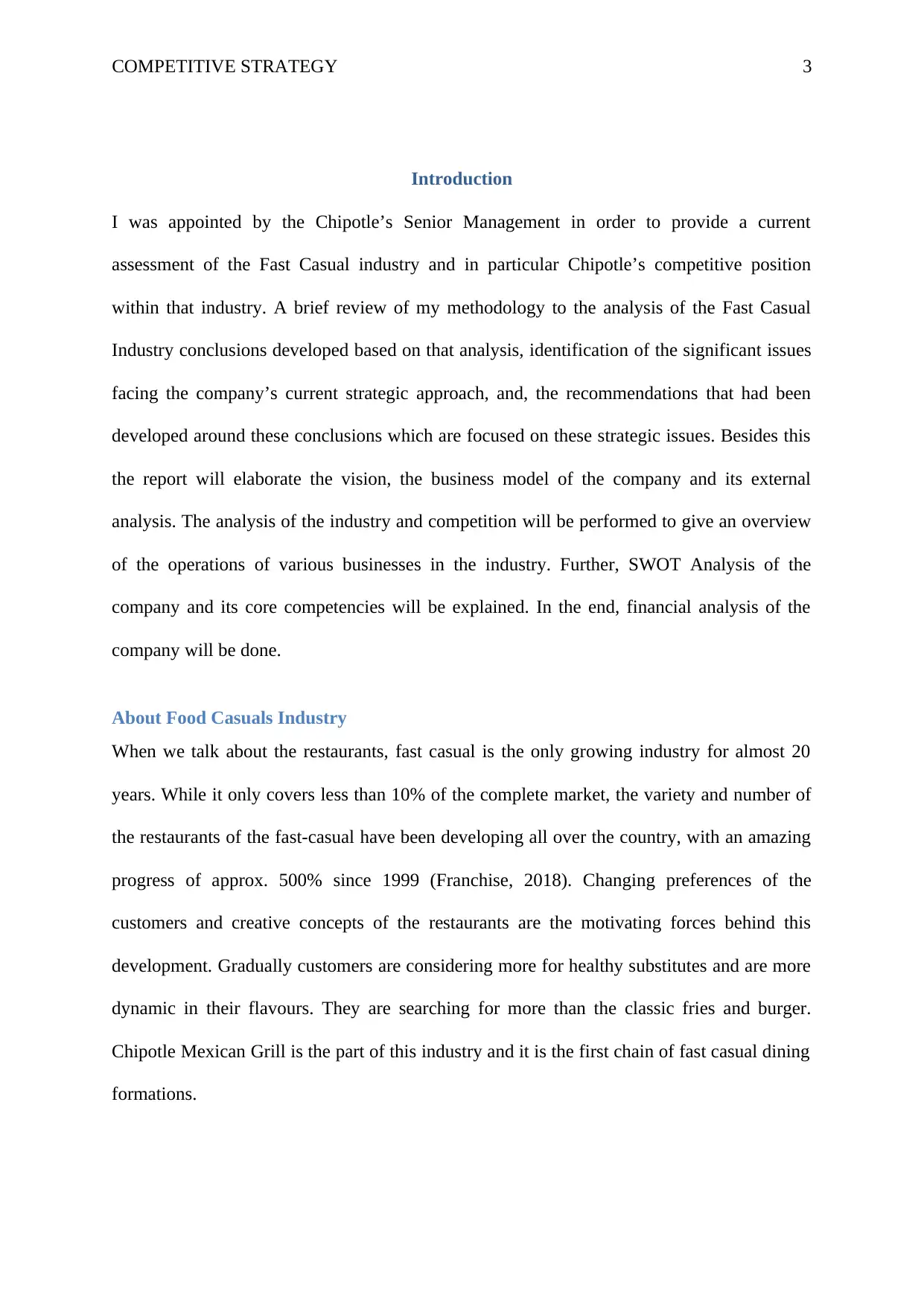
COMPETITIVE STRATEGY 3
Introduction
I was appointed by the Chipotle’s Senior Management in order to provide a current
assessment of the Fast Casual industry and in particular Chipotle’s competitive position
within that industry. A brief review of my methodology to the analysis of the Fast Casual
Industry conclusions developed based on that analysis, identification of the significant issues
facing the company’s current strategic approach, and, the recommendations that had been
developed around these conclusions which are focused on these strategic issues. Besides this
the report will elaborate the vision, the business model of the company and its external
analysis. The analysis of the industry and competition will be performed to give an overview
of the operations of various businesses in the industry. Further, SWOT Analysis of the
company and its core competencies will be explained. In the end, financial analysis of the
company will be done.
About Food Casuals Industry
When we talk about the restaurants, fast casual is the only growing industry for almost 20
years. While it only covers less than 10% of the complete market, the variety and number of
the restaurants of the fast-casual have been developing all over the country, with an amazing
progress of approx. 500% since 1999 (Franchise, 2018). Changing preferences of the
customers and creative concepts of the restaurants are the motivating forces behind this
development. Gradually customers are considering more for healthy substitutes and are more
dynamic in their flavours. They are searching for more than the classic fries and burger.
Chipotle Mexican Grill is the part of this industry and it is the first chain of fast casual dining
formations.
Introduction
I was appointed by the Chipotle’s Senior Management in order to provide a current
assessment of the Fast Casual industry and in particular Chipotle’s competitive position
within that industry. A brief review of my methodology to the analysis of the Fast Casual
Industry conclusions developed based on that analysis, identification of the significant issues
facing the company’s current strategic approach, and, the recommendations that had been
developed around these conclusions which are focused on these strategic issues. Besides this
the report will elaborate the vision, the business model of the company and its external
analysis. The analysis of the industry and competition will be performed to give an overview
of the operations of various businesses in the industry. Further, SWOT Analysis of the
company and its core competencies will be explained. In the end, financial analysis of the
company will be done.
About Food Casuals Industry
When we talk about the restaurants, fast casual is the only growing industry for almost 20
years. While it only covers less than 10% of the complete market, the variety and number of
the restaurants of the fast-casual have been developing all over the country, with an amazing
progress of approx. 500% since 1999 (Franchise, 2018). Changing preferences of the
customers and creative concepts of the restaurants are the motivating forces behind this
development. Gradually customers are considering more for healthy substitutes and are more
dynamic in their flavours. They are searching for more than the classic fries and burger.
Chipotle Mexican Grill is the part of this industry and it is the first chain of fast casual dining
formations.
Paraphrase This Document
Need a fresh take? Get an instant paraphrase of this document with our AI Paraphraser
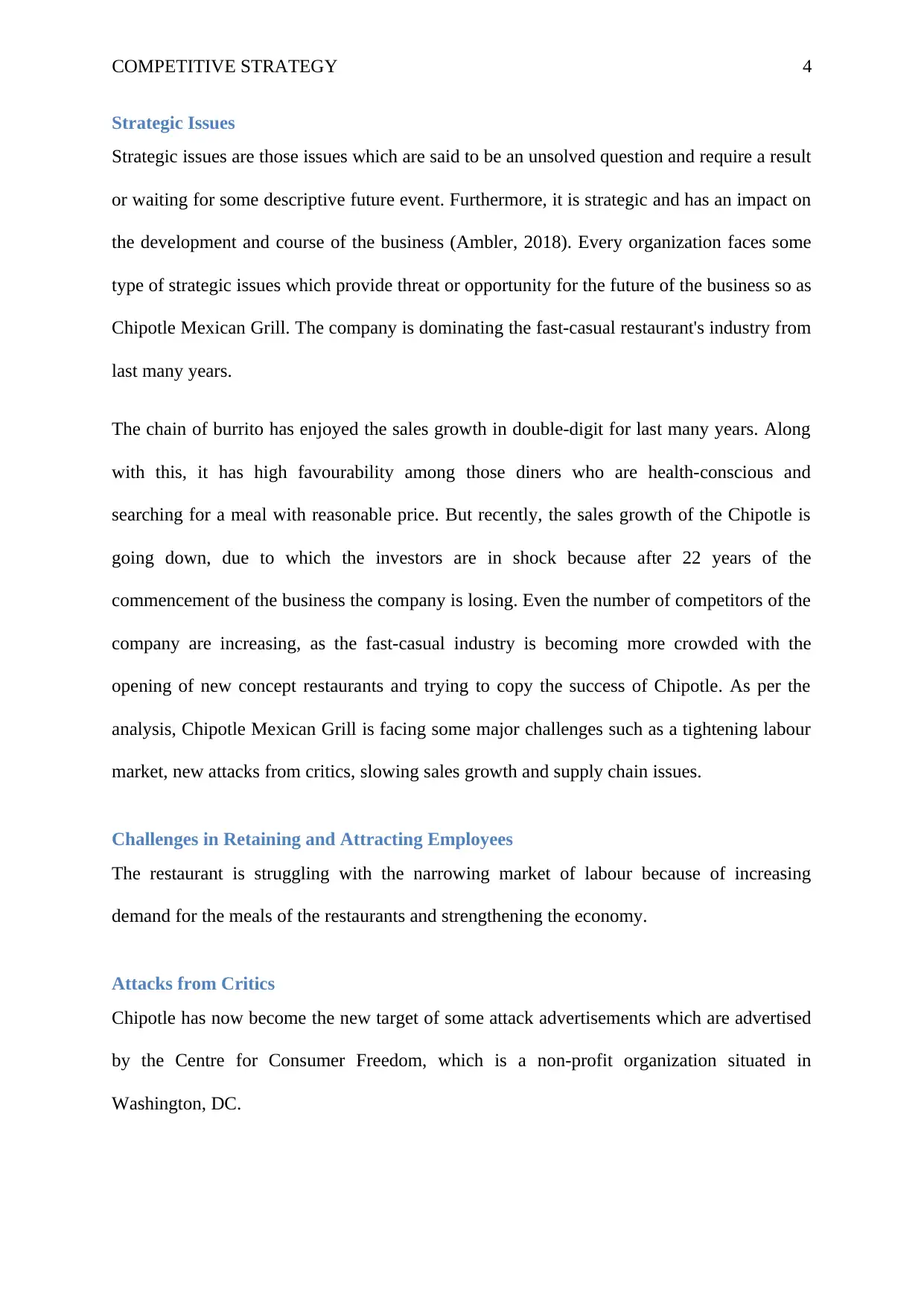
COMPETITIVE STRATEGY 4
Strategic Issues
Strategic issues are those issues which are said to be an unsolved question and require a result
or waiting for some descriptive future event. Furthermore, it is strategic and has an impact on
the development and course of the business (Ambler, 2018). Every organization faces some
type of strategic issues which provide threat or opportunity for the future of the business so as
Chipotle Mexican Grill. The company is dominating the fast-casual restaurant's industry from
last many years.
The chain of burrito has enjoyed the sales growth in double-digit for last many years. Along
with this, it has high favourability among those diners who are health-conscious and
searching for a meal with reasonable price. But recently, the sales growth of the Chipotle is
going down, due to which the investors are in shock because after 22 years of the
commencement of the business the company is losing. Even the number of competitors of the
company are increasing, as the fast-casual industry is becoming more crowded with the
opening of new concept restaurants and trying to copy the success of Chipotle. As per the
analysis, Chipotle Mexican Grill is facing some major challenges such as a tightening labour
market, new attacks from critics, slowing sales growth and supply chain issues.
Challenges in Retaining and Attracting Employees
The restaurant is struggling with the narrowing market of labour because of increasing
demand for the meals of the restaurants and strengthening the economy.
Attacks from Critics
Chipotle has now become the new target of some attack advertisements which are advertised
by the Centre for Consumer Freedom, which is a non-profit organization situated in
Washington, DC.
Strategic Issues
Strategic issues are those issues which are said to be an unsolved question and require a result
or waiting for some descriptive future event. Furthermore, it is strategic and has an impact on
the development and course of the business (Ambler, 2018). Every organization faces some
type of strategic issues which provide threat or opportunity for the future of the business so as
Chipotle Mexican Grill. The company is dominating the fast-casual restaurant's industry from
last many years.
The chain of burrito has enjoyed the sales growth in double-digit for last many years. Along
with this, it has high favourability among those diners who are health-conscious and
searching for a meal with reasonable price. But recently, the sales growth of the Chipotle is
going down, due to which the investors are in shock because after 22 years of the
commencement of the business the company is losing. Even the number of competitors of the
company are increasing, as the fast-casual industry is becoming more crowded with the
opening of new concept restaurants and trying to copy the success of Chipotle. As per the
analysis, Chipotle Mexican Grill is facing some major challenges such as a tightening labour
market, new attacks from critics, slowing sales growth and supply chain issues.
Challenges in Retaining and Attracting Employees
The restaurant is struggling with the narrowing market of labour because of increasing
demand for the meals of the restaurants and strengthening the economy.
Attacks from Critics
Chipotle has now become the new target of some attack advertisements which are advertised
by the Centre for Consumer Freedom, which is a non-profit organization situated in
Washington, DC.
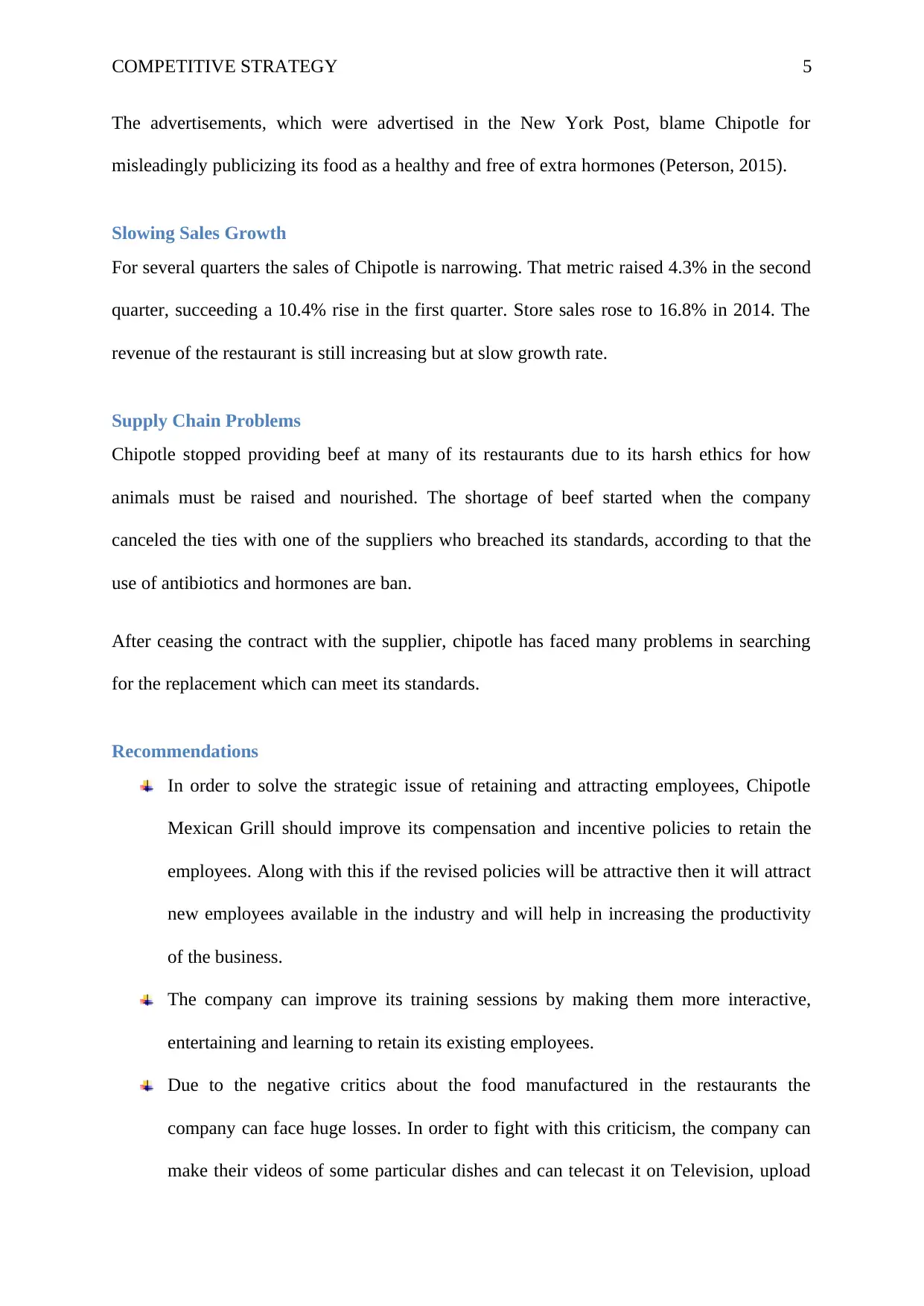
COMPETITIVE STRATEGY 5
The advertisements, which were advertised in the New York Post, blame Chipotle for
misleadingly publicizing its food as a healthy and free of extra hormones (Peterson, 2015).
Slowing Sales Growth
For several quarters the sales of Chipotle is narrowing. That metric raised 4.3% in the second
quarter, succeeding a 10.4% rise in the first quarter. Store sales rose to 16.8% in 2014. The
revenue of the restaurant is still increasing but at slow growth rate.
Supply Chain Problems
Chipotle stopped providing beef at many of its restaurants due to its harsh ethics for how
animals must be raised and nourished. The shortage of beef started when the company
canceled the ties with one of the suppliers who breached its standards, according to that the
use of antibiotics and hormones are ban.
After ceasing the contract with the supplier, chipotle has faced many problems in searching
for the replacement which can meet its standards.
Recommendations
In order to solve the strategic issue of retaining and attracting employees, Chipotle
Mexican Grill should improve its compensation and incentive policies to retain the
employees. Along with this if the revised policies will be attractive then it will attract
new employees available in the industry and will help in increasing the productivity
of the business.
The company can improve its training sessions by making them more interactive,
entertaining and learning to retain its existing employees.
Due to the negative critics about the food manufactured in the restaurants the
company can face huge losses. In order to fight with this criticism, the company can
make their videos of some particular dishes and can telecast it on Television, upload
The advertisements, which were advertised in the New York Post, blame Chipotle for
misleadingly publicizing its food as a healthy and free of extra hormones (Peterson, 2015).
Slowing Sales Growth
For several quarters the sales of Chipotle is narrowing. That metric raised 4.3% in the second
quarter, succeeding a 10.4% rise in the first quarter. Store sales rose to 16.8% in 2014. The
revenue of the restaurant is still increasing but at slow growth rate.
Supply Chain Problems
Chipotle stopped providing beef at many of its restaurants due to its harsh ethics for how
animals must be raised and nourished. The shortage of beef started when the company
canceled the ties with one of the suppliers who breached its standards, according to that the
use of antibiotics and hormones are ban.
After ceasing the contract with the supplier, chipotle has faced many problems in searching
for the replacement which can meet its standards.
Recommendations
In order to solve the strategic issue of retaining and attracting employees, Chipotle
Mexican Grill should improve its compensation and incentive policies to retain the
employees. Along with this if the revised policies will be attractive then it will attract
new employees available in the industry and will help in increasing the productivity
of the business.
The company can improve its training sessions by making them more interactive,
entertaining and learning to retain its existing employees.
Due to the negative critics about the food manufactured in the restaurants the
company can face huge losses. In order to fight with this criticism, the company can
make their videos of some particular dishes and can telecast it on Television, upload
⊘ This is a preview!⊘
Do you want full access?
Subscribe today to unlock all pages.

Trusted by 1+ million students worldwide
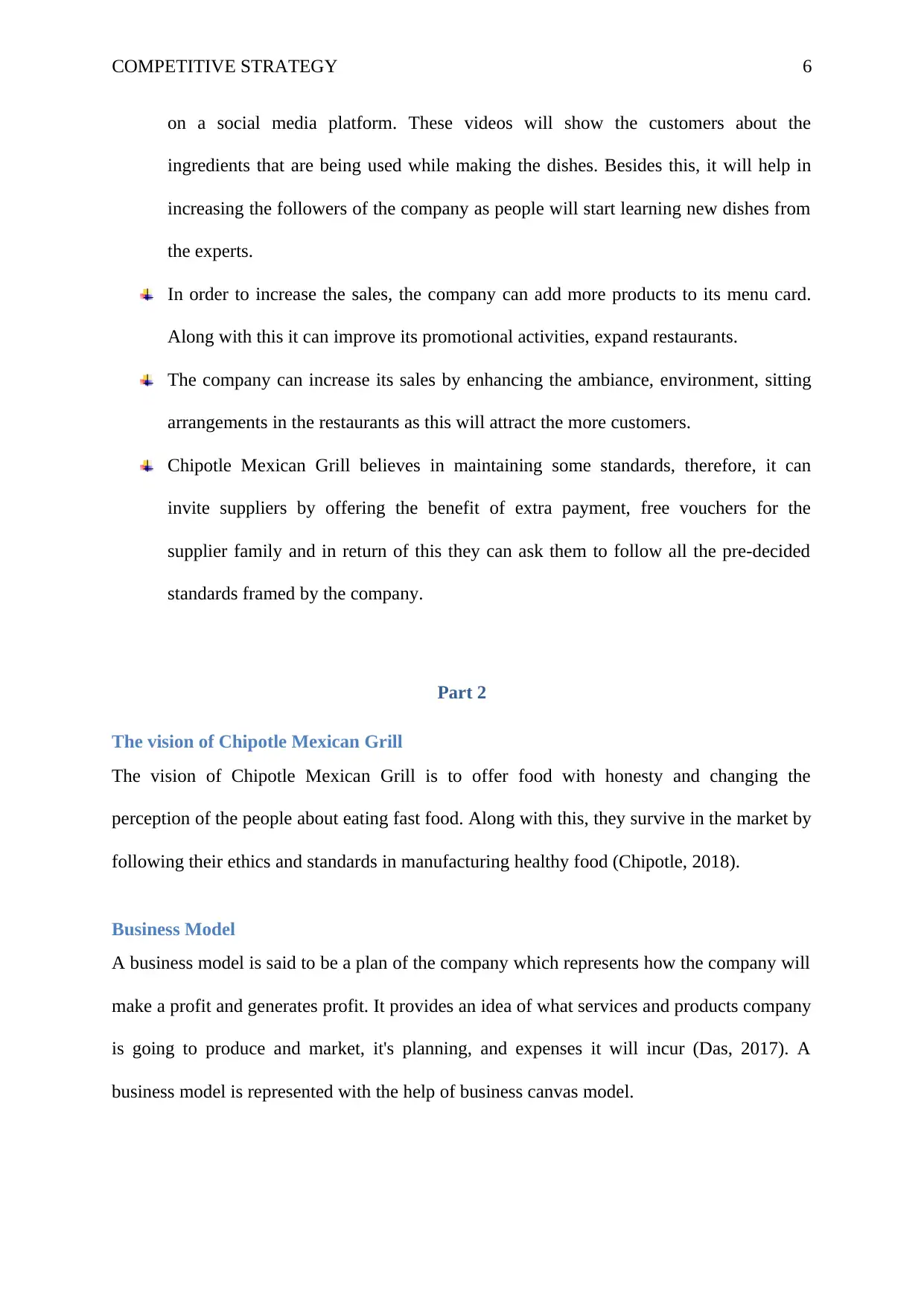
COMPETITIVE STRATEGY 6
on a social media platform. These videos will show the customers about the
ingredients that are being used while making the dishes. Besides this, it will help in
increasing the followers of the company as people will start learning new dishes from
the experts.
In order to increase the sales, the company can add more products to its menu card.
Along with this it can improve its promotional activities, expand restaurants.
The company can increase its sales by enhancing the ambiance, environment, sitting
arrangements in the restaurants as this will attract the more customers.
Chipotle Mexican Grill believes in maintaining some standards, therefore, it can
invite suppliers by offering the benefit of extra payment, free vouchers for the
supplier family and in return of this they can ask them to follow all the pre-decided
standards framed by the company.
Part 2
The vision of Chipotle Mexican Grill
The vision of Chipotle Mexican Grill is to offer food with honesty and changing the
perception of the people about eating fast food. Along with this, they survive in the market by
following their ethics and standards in manufacturing healthy food (Chipotle, 2018).
Business Model
A business model is said to be a plan of the company which represents how the company will
make a profit and generates profit. It provides an idea of what services and products company
is going to produce and market, it's planning, and expenses it will incur (Das, 2017). A
business model is represented with the help of business canvas model.
on a social media platform. These videos will show the customers about the
ingredients that are being used while making the dishes. Besides this, it will help in
increasing the followers of the company as people will start learning new dishes from
the experts.
In order to increase the sales, the company can add more products to its menu card.
Along with this it can improve its promotional activities, expand restaurants.
The company can increase its sales by enhancing the ambiance, environment, sitting
arrangements in the restaurants as this will attract the more customers.
Chipotle Mexican Grill believes in maintaining some standards, therefore, it can
invite suppliers by offering the benefit of extra payment, free vouchers for the
supplier family and in return of this they can ask them to follow all the pre-decided
standards framed by the company.
Part 2
The vision of Chipotle Mexican Grill
The vision of Chipotle Mexican Grill is to offer food with honesty and changing the
perception of the people about eating fast food. Along with this, they survive in the market by
following their ethics and standards in manufacturing healthy food (Chipotle, 2018).
Business Model
A business model is said to be a plan of the company which represents how the company will
make a profit and generates profit. It provides an idea of what services and products company
is going to produce and market, it's planning, and expenses it will incur (Das, 2017). A
business model is represented with the help of business canvas model.
Paraphrase This Document
Need a fresh take? Get an instant paraphrase of this document with our AI Paraphraser
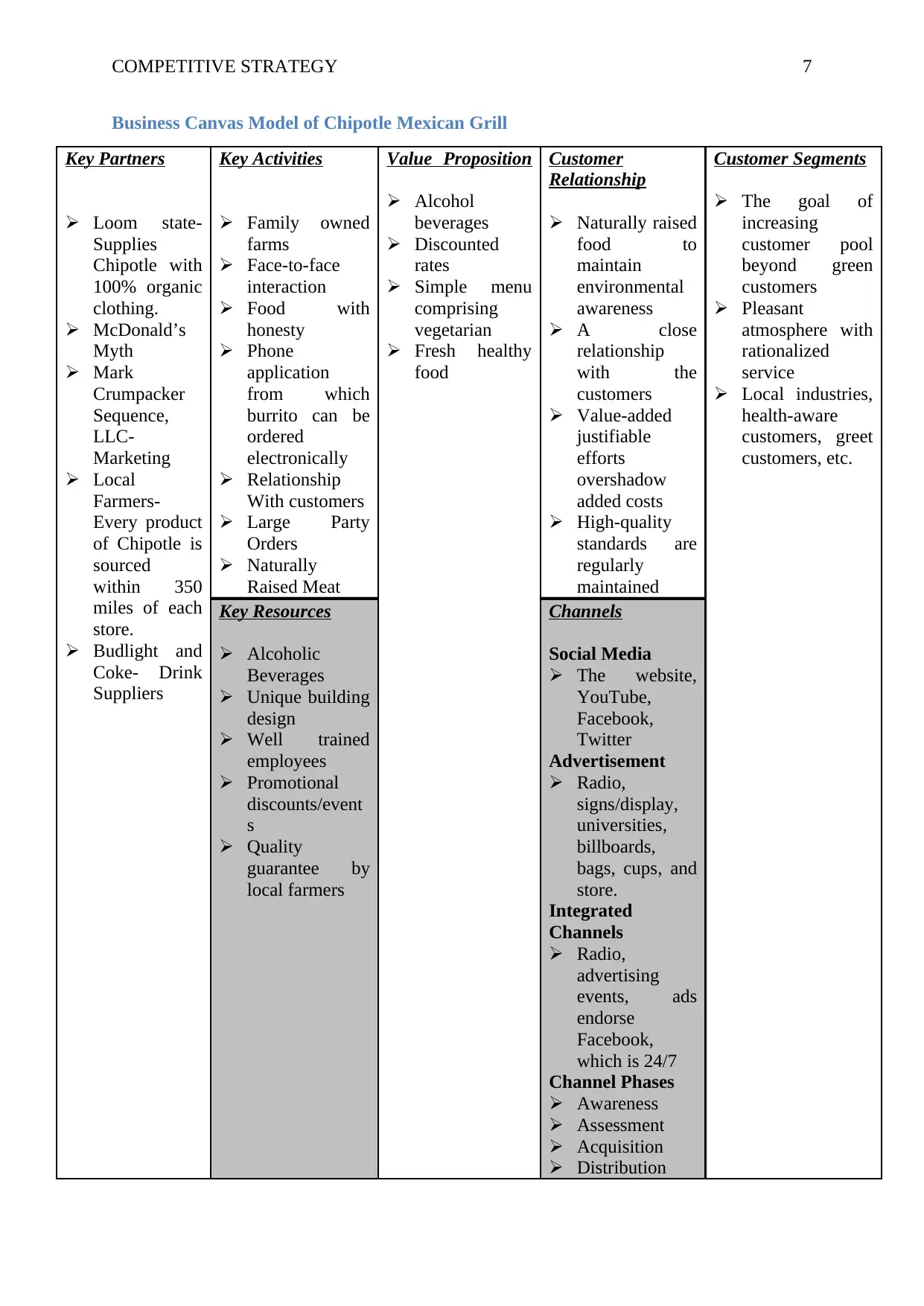
COMPETITIVE STRATEGY 7
Business Canvas Model of Chipotle Mexican Grill
Key Partners
Loom state-
Supplies
Chipotle with
100% organic
clothing.
McDonald’s
Myth
Mark
Crumpacker
Sequence,
LLC-
Marketing
Local
Farmers-
Every product
of Chipotle is
sourced
within 350
miles of each
store.
Budlight and
Coke- Drink
Suppliers
Key Activities
Family owned
farms
Face-to-face
interaction
Food with
honesty
Phone
application
from which
burrito can be
ordered
electronically
Relationship
With customers
Large Party
Orders
Naturally
Raised Meat
Value Proposition
Alcohol
beverages
Discounted
rates
Simple menu
comprising
vegetarian
Fresh healthy
food
Customer
Relationship
Naturally raised
food to
maintain
environmental
awareness
A close
relationship
with the
customers
Value-added
justifiable
efforts
overshadow
added costs
High-quality
standards are
regularly
maintained
Customer Segments
The goal of
increasing
customer pool
beyond green
customers
Pleasant
atmosphere with
rationalized
service
Local industries,
health-aware
customers, greet
customers, etc.
Key Resources
Alcoholic
Beverages
Unique building
design
Well trained
employees
Promotional
discounts/event
s
Quality
guarantee by
local farmers
Channels
Social Media
The website,
YouTube,
Facebook,
Twitter
Advertisement
Radio,
signs/display,
universities,
billboards,
bags, cups, and
store.
Integrated
Channels
Radio,
advertising
events, ads
endorse
Facebook,
which is 24/7
Channel Phases
Awareness
Assessment
Acquisition
Distribution
Business Canvas Model of Chipotle Mexican Grill
Key Partners
Loom state-
Supplies
Chipotle with
100% organic
clothing.
McDonald’s
Myth
Mark
Crumpacker
Sequence,
LLC-
Marketing
Local
Farmers-
Every product
of Chipotle is
sourced
within 350
miles of each
store.
Budlight and
Coke- Drink
Suppliers
Key Activities
Family owned
farms
Face-to-face
interaction
Food with
honesty
Phone
application
from which
burrito can be
ordered
electronically
Relationship
With customers
Large Party
Orders
Naturally
Raised Meat
Value Proposition
Alcohol
beverages
Discounted
rates
Simple menu
comprising
vegetarian
Fresh healthy
food
Customer
Relationship
Naturally raised
food to
maintain
environmental
awareness
A close
relationship
with the
customers
Value-added
justifiable
efforts
overshadow
added costs
High-quality
standards are
regularly
maintained
Customer Segments
The goal of
increasing
customer pool
beyond green
customers
Pleasant
atmosphere with
rationalized
service
Local industries,
health-aware
customers, greet
customers, etc.
Key Resources
Alcoholic
Beverages
Unique building
design
Well trained
employees
Promotional
discounts/event
s
Quality
guarantee by
local farmers
Channels
Social Media
The website,
YouTube,
Facebook,
Advertisement
Radio,
signs/display,
universities,
billboards,
bags, cups, and
store.
Integrated
Channels
Radio,
advertising
events, ads
endorse
Facebook,
which is 24/7
Channel Phases
Awareness
Assessment
Acquisition
Distribution
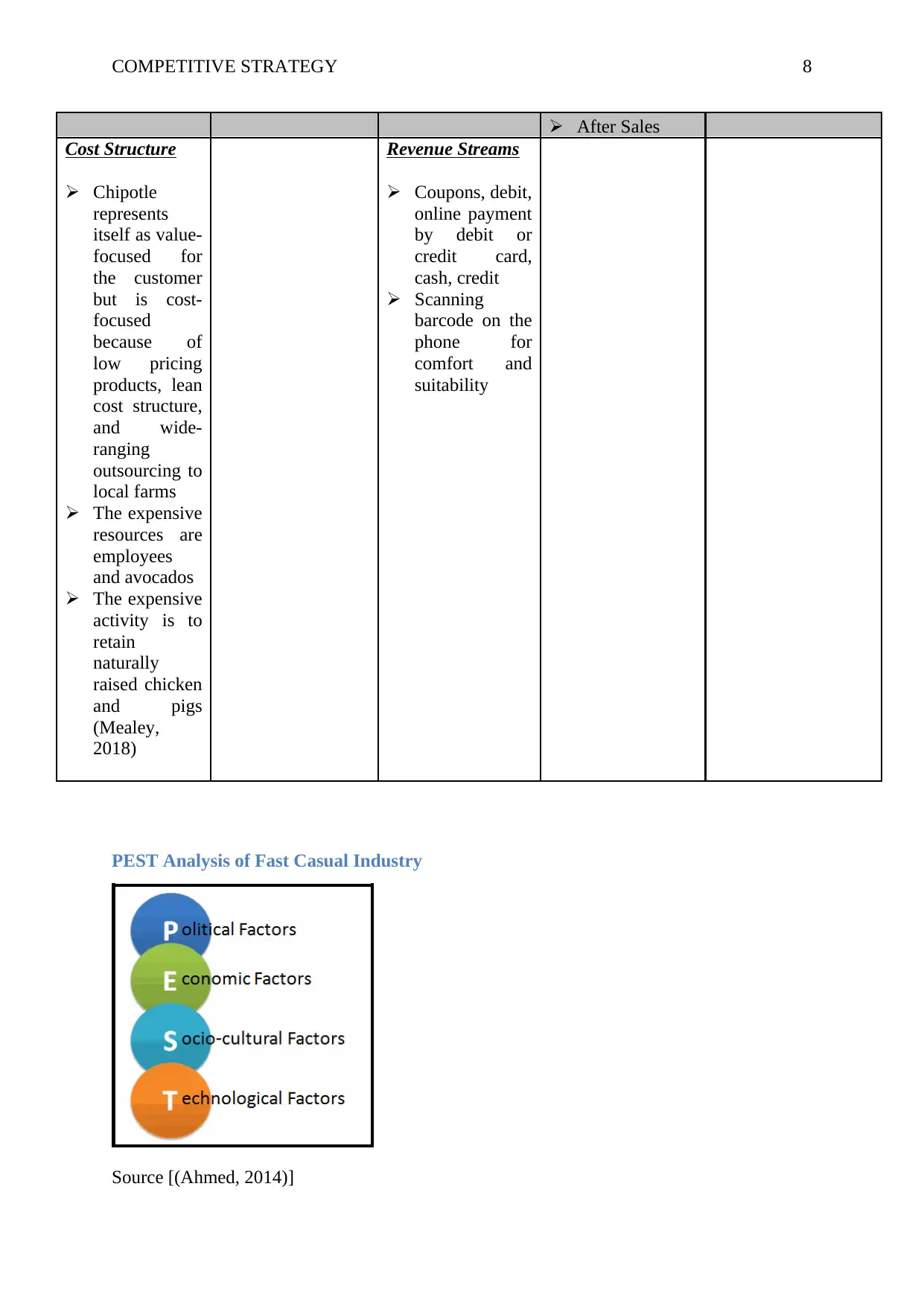
COMPETITIVE STRATEGY 8
After Sales
Cost Structure
Chipotle
represents
itself as value-
focused for
the customer
but is cost-
focused
because of
low pricing
products, lean
cost structure,
and wide-
ranging
outsourcing to
local farms
The expensive
resources are
employees
and avocados
The expensive
activity is to
retain
naturally
raised chicken
and pigs
(Mealey,
2018)
Revenue Streams
Coupons, debit,
online payment
by debit or
credit card,
cash, credit
Scanning
barcode on the
phone for
comfort and
suitability
PEST Analysis of Fast Casual Industry
Source [(Ahmed, 2014)]
After Sales
Cost Structure
Chipotle
represents
itself as value-
focused for
the customer
but is cost-
focused
because of
low pricing
products, lean
cost structure,
and wide-
ranging
outsourcing to
local farms
The expensive
resources are
employees
and avocados
The expensive
activity is to
retain
naturally
raised chicken
and pigs
(Mealey,
2018)
Revenue Streams
Coupons, debit,
online payment
by debit or
credit card,
cash, credit
Scanning
barcode on the
phone for
comfort and
suitability
PEST Analysis of Fast Casual Industry
Source [(Ahmed, 2014)]
⊘ This is a preview!⊘
Do you want full access?
Subscribe today to unlock all pages.

Trusted by 1+ million students worldwide
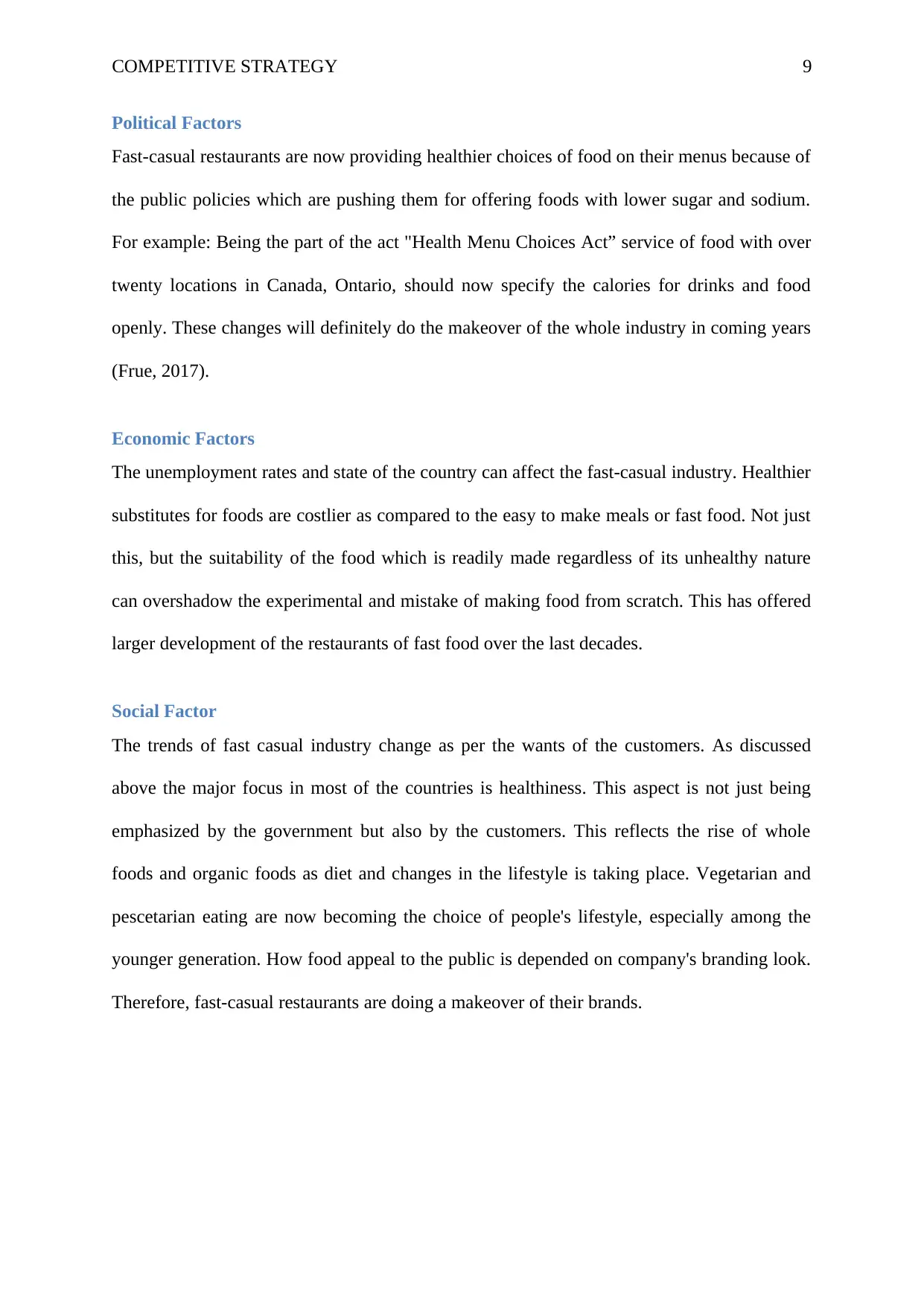
COMPETITIVE STRATEGY 9
Political Factors
Fast-casual restaurants are now providing healthier choices of food on their menus because of
the public policies which are pushing them for offering foods with lower sugar and sodium.
For example: Being the part of the act "Health Menu Choices Act” service of food with over
twenty locations in Canada, Ontario, should now specify the calories for drinks and food
openly. These changes will definitely do the makeover of the whole industry in coming years
(Frue, 2017).
Economic Factors
The unemployment rates and state of the country can affect the fast-casual industry. Healthier
substitutes for foods are costlier as compared to the easy to make meals or fast food. Not just
this, but the suitability of the food which is readily made regardless of its unhealthy nature
can overshadow the experimental and mistake of making food from scratch. This has offered
larger development of the restaurants of fast food over the last decades.
Social Factor
The trends of fast casual industry change as per the wants of the customers. As discussed
above the major focus in most of the countries is healthiness. This aspect is not just being
emphasized by the government but also by the customers. This reflects the rise of whole
foods and organic foods as diet and changes in the lifestyle is taking place. Vegetarian and
pescetarian eating are now becoming the choice of people's lifestyle, especially among the
younger generation. How food appeal to the public is depended on company's branding look.
Therefore, fast-casual restaurants are doing a makeover of their brands.
Political Factors
Fast-casual restaurants are now providing healthier choices of food on their menus because of
the public policies which are pushing them for offering foods with lower sugar and sodium.
For example: Being the part of the act "Health Menu Choices Act” service of food with over
twenty locations in Canada, Ontario, should now specify the calories for drinks and food
openly. These changes will definitely do the makeover of the whole industry in coming years
(Frue, 2017).
Economic Factors
The unemployment rates and state of the country can affect the fast-casual industry. Healthier
substitutes for foods are costlier as compared to the easy to make meals or fast food. Not just
this, but the suitability of the food which is readily made regardless of its unhealthy nature
can overshadow the experimental and mistake of making food from scratch. This has offered
larger development of the restaurants of fast food over the last decades.
Social Factor
The trends of fast casual industry change as per the wants of the customers. As discussed
above the major focus in most of the countries is healthiness. This aspect is not just being
emphasized by the government but also by the customers. This reflects the rise of whole
foods and organic foods as diet and changes in the lifestyle is taking place. Vegetarian and
pescetarian eating are now becoming the choice of people's lifestyle, especially among the
younger generation. How food appeal to the public is depended on company's branding look.
Therefore, fast-casual restaurants are doing a makeover of their brands.
Paraphrase This Document
Need a fresh take? Get an instant paraphrase of this document with our AI Paraphraser
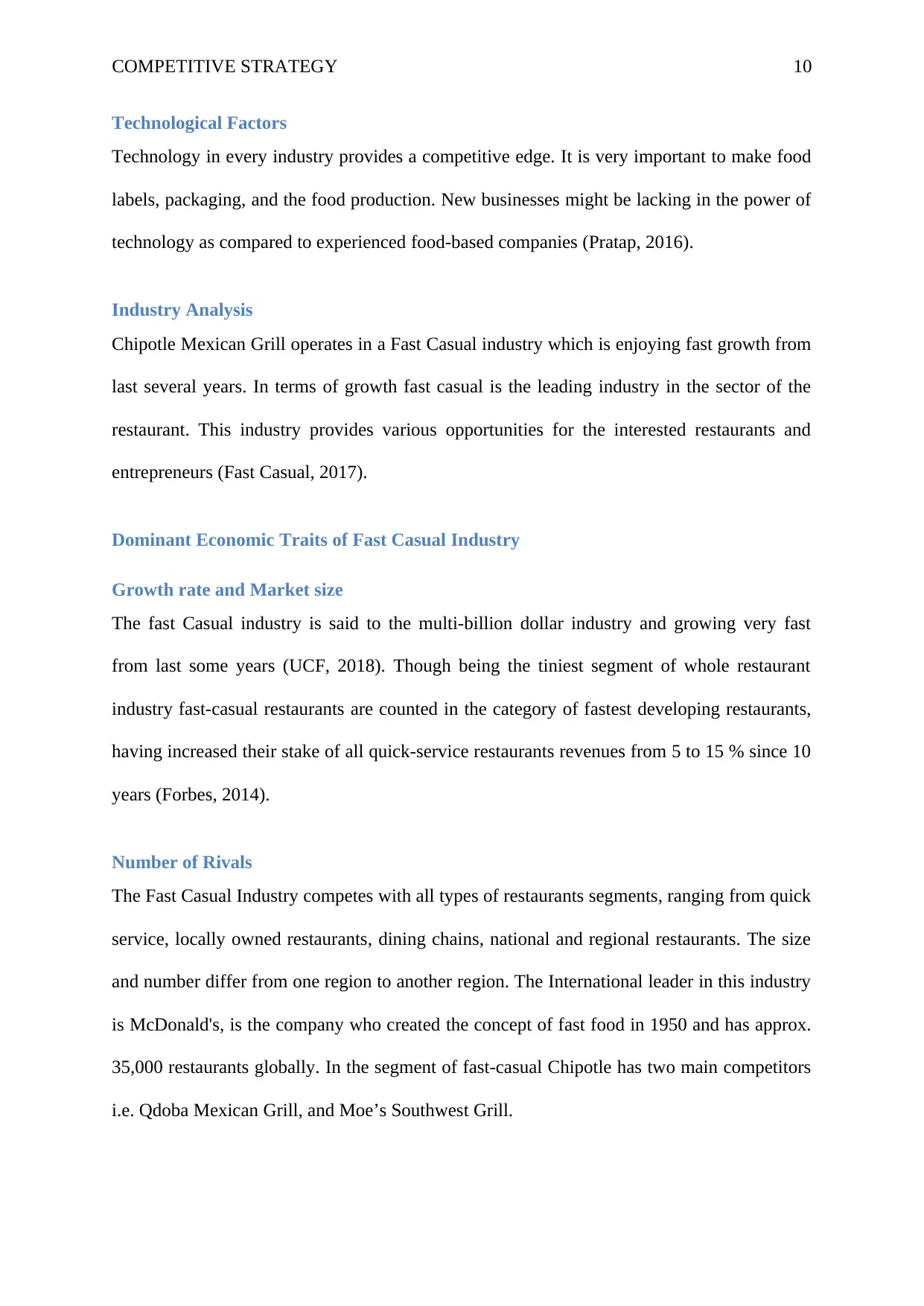
COMPETITIVE STRATEGY 10
Technological Factors
Technology in every industry provides a competitive edge. It is very important to make food
labels, packaging, and the food production. New businesses might be lacking in the power of
technology as compared to experienced food-based companies (Pratap, 2016).
Industry Analysis
Chipotle Mexican Grill operates in a Fast Casual industry which is enjoying fast growth from
last several years. In terms of growth fast casual is the leading industry in the sector of the
restaurant. This industry provides various opportunities for the interested restaurants and
entrepreneurs (Fast Casual, 2017).
Dominant Economic Traits of Fast Casual Industry
Growth rate and Market size
The fast Casual industry is said to the multi-billion dollar industry and growing very fast
from last some years (UCF, 2018). Though being the tiniest segment of whole restaurant
industry fast-casual restaurants are counted in the category of fastest developing restaurants,
having increased their stake of all quick-service restaurants revenues from 5 to 15 % since 10
years (Forbes, 2014).
Number of Rivals
The Fast Casual Industry competes with all types of restaurants segments, ranging from quick
service, locally owned restaurants, dining chains, national and regional restaurants. The size
and number differ from one region to another region. The International leader in this industry
is McDonald's, is the company who created the concept of fast food in 1950 and has approx.
35,000 restaurants globally. In the segment of fast-casual Chipotle has two main competitors
i.e. Qdoba Mexican Grill, and Moe’s Southwest Grill.
Technological Factors
Technology in every industry provides a competitive edge. It is very important to make food
labels, packaging, and the food production. New businesses might be lacking in the power of
technology as compared to experienced food-based companies (Pratap, 2016).
Industry Analysis
Chipotle Mexican Grill operates in a Fast Casual industry which is enjoying fast growth from
last several years. In terms of growth fast casual is the leading industry in the sector of the
restaurant. This industry provides various opportunities for the interested restaurants and
entrepreneurs (Fast Casual, 2017).
Dominant Economic Traits of Fast Casual Industry
Growth rate and Market size
The fast Casual industry is said to the multi-billion dollar industry and growing very fast
from last some years (UCF, 2018). Though being the tiniest segment of whole restaurant
industry fast-casual restaurants are counted in the category of fastest developing restaurants,
having increased their stake of all quick-service restaurants revenues from 5 to 15 % since 10
years (Forbes, 2014).
Number of Rivals
The Fast Casual Industry competes with all types of restaurants segments, ranging from quick
service, locally owned restaurants, dining chains, national and regional restaurants. The size
and number differ from one region to another region. The International leader in this industry
is McDonald's, is the company who created the concept of fast food in 1950 and has approx.
35,000 restaurants globally. In the segment of fast-casual Chipotle has two main competitors
i.e. Qdoba Mexican Grill, and Moe’s Southwest Grill.
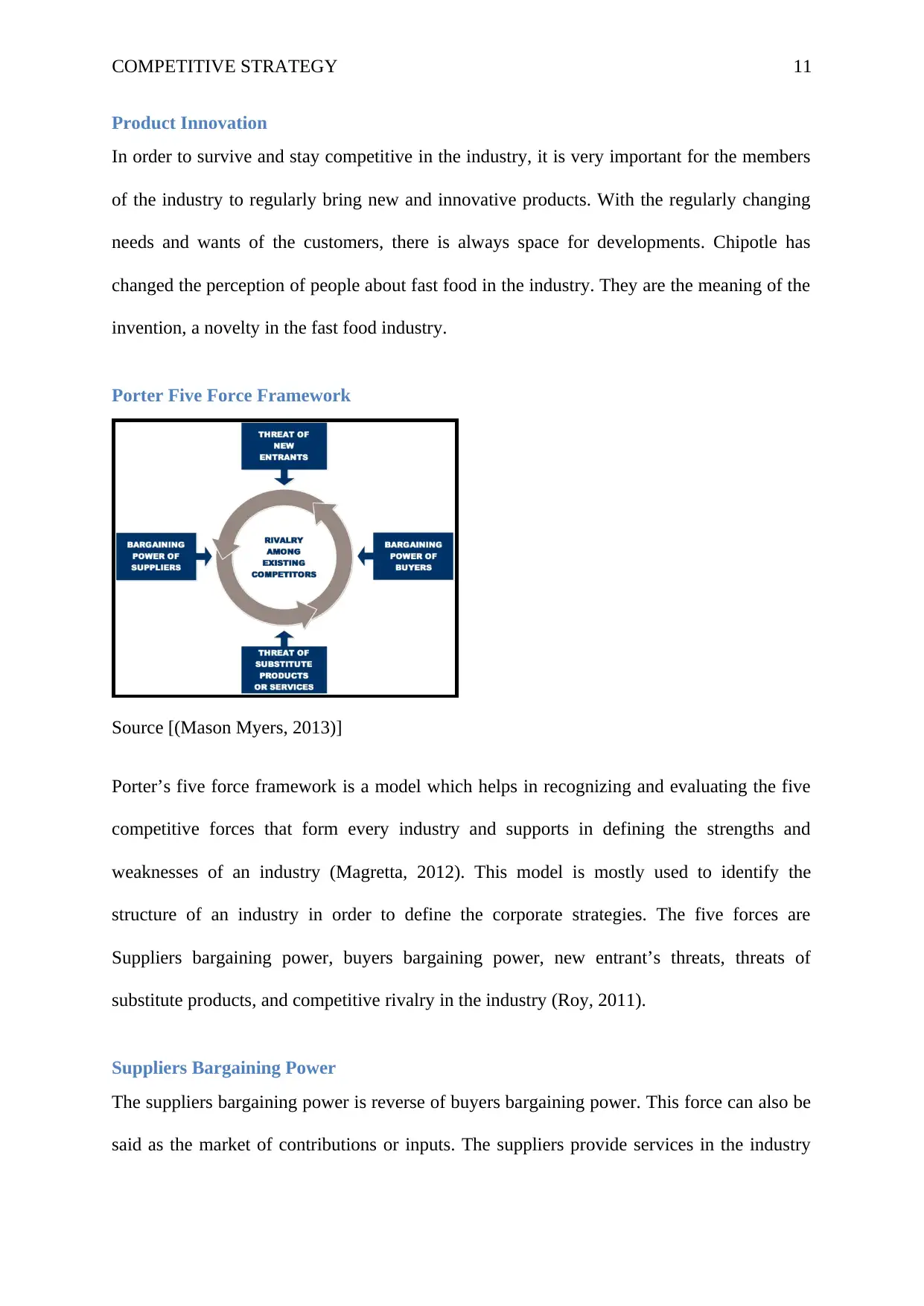
COMPETITIVE STRATEGY 11
Product Innovation
In order to survive and stay competitive in the industry, it is very important for the members
of the industry to regularly bring new and innovative products. With the regularly changing
needs and wants of the customers, there is always space for developments. Chipotle has
changed the perception of people about fast food in the industry. They are the meaning of the
invention, a novelty in the fast food industry.
Porter Five Force Framework
Source [(Mason Myers, 2013)]
Porter’s five force framework is a model which helps in recognizing and evaluating the five
competitive forces that form every industry and supports in defining the strengths and
weaknesses of an industry (Magretta, 2012). This model is mostly used to identify the
structure of an industry in order to define the corporate strategies. The five forces are
Suppliers bargaining power, buyers bargaining power, new entrant’s threats, threats of
substitute products, and competitive rivalry in the industry (Roy, 2011).
Suppliers Bargaining Power
The suppliers bargaining power is reverse of buyers bargaining power. This force can also be
said as the market of contributions or inputs. The suppliers provide services in the industry
Product Innovation
In order to survive and stay competitive in the industry, it is very important for the members
of the industry to regularly bring new and innovative products. With the regularly changing
needs and wants of the customers, there is always space for developments. Chipotle has
changed the perception of people about fast food in the industry. They are the meaning of the
invention, a novelty in the fast food industry.
Porter Five Force Framework
Source [(Mason Myers, 2013)]
Porter’s five force framework is a model which helps in recognizing and evaluating the five
competitive forces that form every industry and supports in defining the strengths and
weaknesses of an industry (Magretta, 2012). This model is mostly used to identify the
structure of an industry in order to define the corporate strategies. The five forces are
Suppliers bargaining power, buyers bargaining power, new entrant’s threats, threats of
substitute products, and competitive rivalry in the industry (Roy, 2011).
Suppliers Bargaining Power
The suppliers bargaining power is reverse of buyers bargaining power. This force can also be
said as the market of contributions or inputs. The suppliers provide services in the industry
⊘ This is a preview!⊘
Do you want full access?
Subscribe today to unlock all pages.

Trusted by 1+ million students worldwide
1 out of 30
Related Documents
Your All-in-One AI-Powered Toolkit for Academic Success.
+13062052269
info@desklib.com
Available 24*7 on WhatsApp / Email
![[object Object]](/_next/static/media/star-bottom.7253800d.svg)
Unlock your academic potential
Copyright © 2020–2025 A2Z Services. All Rights Reserved. Developed and managed by ZUCOL.




